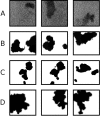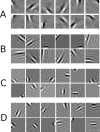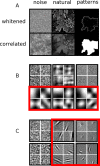Innate visual learning through spontaneous activity patterns
- PMID: 18670593
- PMCID: PMC2446436
- DOI: 10.1371/journal.pcbi.1000137
Innate visual learning through spontaneous activity patterns
Abstract
Patterns of spontaneous activity in the developing retina, LGN, and cortex are necessary for the proper development of visual cortex. With these patterns intact, the primary visual cortices of many newborn animals develop properties similar to those of the adult cortex but without the training benefit of visual experience. Previous models have demonstrated how V1 responses can be initialized through mechanisms specific to development and prior to visual experience, such as using axonal guidance cues or relying on simple, pairwise correlations on spontaneous activity with additional developmental constraints. We argue that these spontaneous patterns may be better understood as part of an "innate learning" strategy, which learns similarly on activity both before and during visual experience. With an abstraction of spontaneous activity models, we show how the visual system may be able to bootstrap an efficient code for its natural environment prior to external visual experience, and we continue the same refinement strategy upon natural experience. The patterns are generated through simple, local interactions and contain the same relevant statistical properties of retinal waves and hypothesized waves in the LGN and V1. An efficient encoding of these patterns resembles a sparse coding of natural images by producing neurons with localized, oriented, bandpass structure-the same code found in early visual cortical cells. We address the relevance of higher-order statistical properties of spontaneous activity, how this relates to a system that may adapt similarly on activity prior to and during natural experience, and how these concepts ultimately relate to an efficient coding of our natural world.
Conflict of interest statement
The authors have declared that no competing interests exist.
Figures




References
-
- Katz LC, Shatz CJ. Synaptic activity and the construction of cortical circuits. Science. 1996;274:1133–1138. - PubMed
-
- Sur M, Rubenstein JLR. Patterning and plasticity of the cerebral cortex. Science. 2005;310:805–810. - PubMed
-
- Wiesel TN, Hubel DH. Ordered arrangement of orientation columns in monkeys lacking visual experience. J Compar Neurol. 1974;158:307–318. - PubMed
Publication types
MeSH terms
Grants and funding
LinkOut - more resources
Full Text Sources

